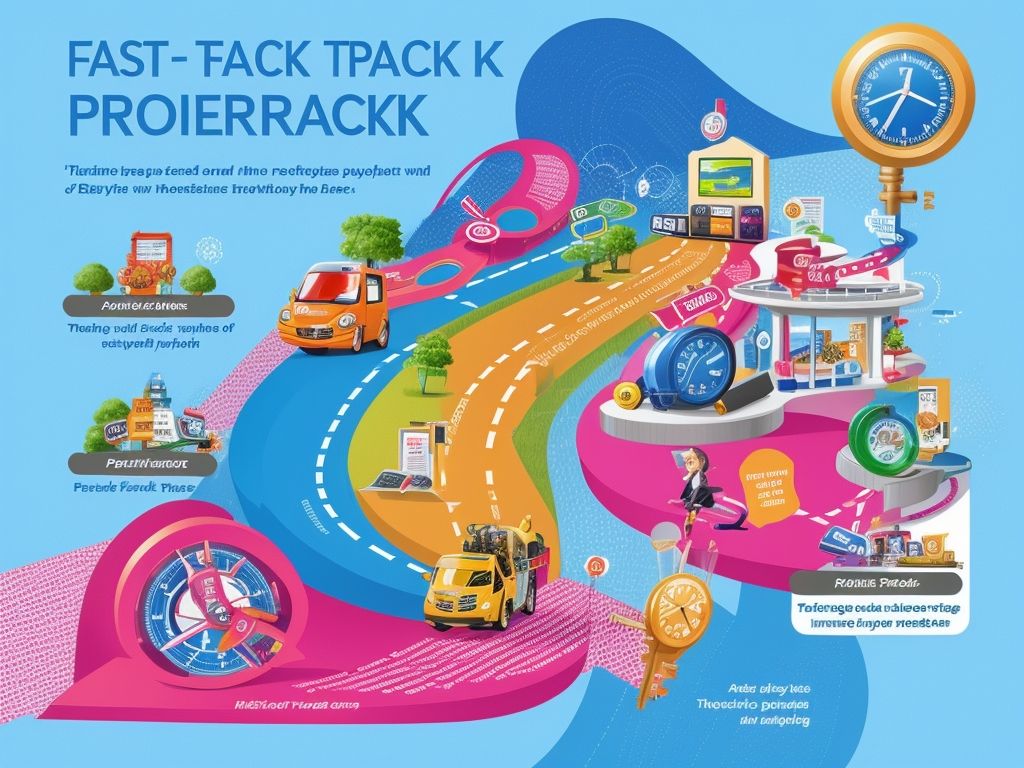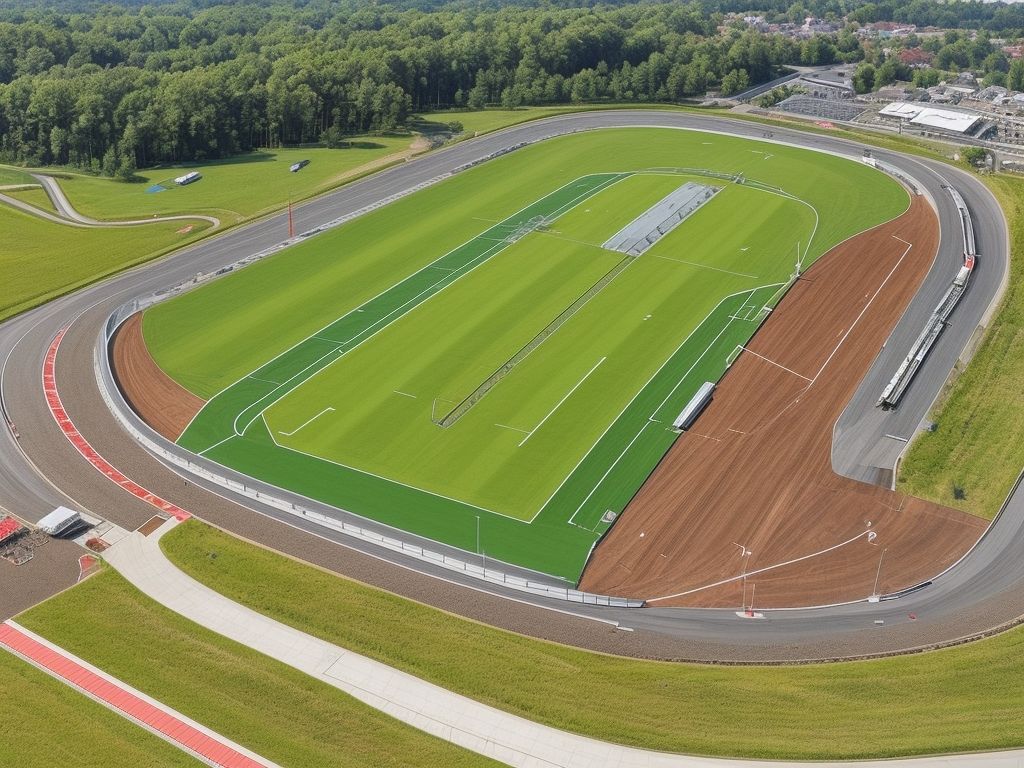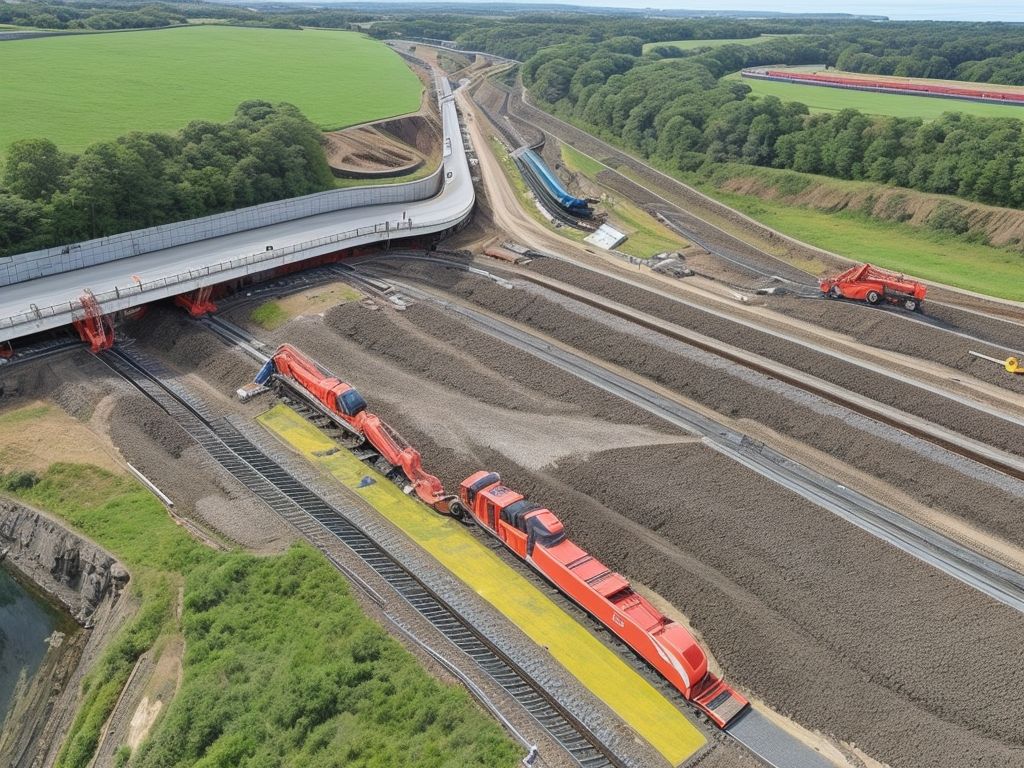Fast Track marketing, also known as rapid or agile marketing, is a dynamic approach that aims to maximize efficiency and results in a shorter timeframe. It involves quickly adapting to changing market trends, making data-driven decisions, and executing targeted campaigns. This strategy differs from traditional marketing by emphasizing speed, adaptability, and efficient resource allocation.
The key components of Fast Track marketing include data-driven decision making, targeted audience identification, and agile campaign execution. By relying on advanced analytics tools, marketers can gather insights and make informed decisions. Identifying the specific audience segments allows for personalized and targeted campaigns. Agile campaign execution involves implementing strategies quickly and making adjustments based on real-time feedback.
The benefits of Fast Track marketing include efficient resource allocation, higher return on investment (ROI), and quick adaptability to market trends. With a focus on data and analytics, marketers can allocate resources effectively, ensuring maximum impact. The agile nature of Fast Track marketing allows for quick adjustments to capitalize on emerging trends and opportunities, resulting in higher ROI.
However, there are challenges and risks associated with Fast Track marketing, including shorter timeframes and deadlines, potential for oversights and mistakes, and increased pressure on marketing teams. The fast-paced nature of this strategy can create pressure to meet tight deadlines, increasing the risk of errors. Marketing teams must work efficiently and collaboratively to mitigate these challenges.
Implementing Fast Track marketing requires following best practices such as utilizing advanced analytics tools to gather data-driven insights, creating collaborative workflows to streamline communication and decision-making processes, and continuously monitoring and optimizing campaigns for maximum effectiveness.
Key takeaway:
- Fast Track marketing maximizes efficiency: With data-driven decision making, targeted audience identification, and agile campaign execution, Fast Track marketing allows for efficient resource allocation, resulting in higher ROI and quick adaptability to market trends.
- Challenges and risks of Fast Track marketing: Shorter timeframes and deadlines may increase pressure on marketing teams and lead to potential oversights and mistakes. However, implementing best practices such as utilizing advanced analytics tools, creating collaborative workflows, and continuous monitoring and optimization can mitigate these risks.
What is Fast Track in Marketing?

Photo Credits: Runningtrackresurfacing.Uk by Henry Adams
Fast Track in Marketing refers to a strategy or approach that speeds up the process of achieving marketing goals and objectives. It involves implementing various techniques and tactics to expedite marketing campaigns and achieve desired outcomes efficiently.
There are several ways in which Fast Track can be implemented in marketing:
1. Streamlined Processes: Fast Track in marketing involves optimising and streamlining processes to ensure efficiency and effectiveness. This includes automating repetitive tasks, using technology for data analysis, and implementing agile project management methodologies.
2. Targeted Campaigns: Fast Track marketing focuses on creating targeted campaigns that effectively reach the intended audience. By conducting extensive market research and using data analytics, marketers can identify the most relevant target segments and tailor their campaigns accordingly.
3. Agile Decision-making: Fast Track marketing requires quick decision-making based on real-time data and insights. Marketers need to be agile and adaptable in responding to changing market conditions and consumer preferences.
4. Multi-channel Approach: Fast Track marketing involves leveraging multiple channels to maximise reach and engagement. This may include using social media platforms, email marketing, content marketing, search engine optimisation, and paid advertising.
5. Continuous Optimisation: Fast Track marketing emphasises continuous optimisation of campaigns and strategies. Marketers need to consistently analyse and measure the performance of their marketing activities, identify areas for improvement, and make necessary adjustments.
Fast Track in marketing enables businesses to achieve faster results, increase customer engagement, and gain a competitive edge. By implementing efficient processes, targeting the right audience, making agile decisions, utilising multiple channels, and continuously optimising strategies, marketers can effectively achieve their marketing objectives.
Overview of Fast Track Marketing Strategy

Photo Credits: Runningtrackresurfacing.Uk by Billy Jackson
The
The fast track marketing strategy is a proactive approach designed to rapidly promote and sell products or services. It allows businesses to quickly penetrate the market and gain a competitive edge. This strategy focuses on generating immediate results and maximizing profits.
1. Targeted Advertising: Fast track marketing involves identifying and targeting a specific audience through precise advertising techniques. By tailoring messages and content to a particular demographic, businesses can effectively reach their intended customers.
2. Aggressive Promotion: This strategy involves launching intensive promotional campaigns to create brand awareness and generate sales. Tactics such as discounts, limited-time offers, and product giveaways can entice customers to make immediate purchases.
3. Strategic Partnerships: Collaborating with other businesses or influencers can significantly boost a brand’s visibility and credibility. Partnering with well-established companies or industry leaders can help expand reach and tap into new customer bases.
4. Rapid Sales Channels: Adopting fast and convenient sales channels, such as online platforms or mobile apps, enables businesses to reach customers quickly and increase the chances of immediate sales. Streamlining the purchasing process enhances customer satisfaction and encourages repeat business.
5. Continuous Improvement: Fast track marketing requires regularly reviewing and analyzing campaign performance to identify areas for improvement. Analytics and customer feedback help refine strategies and optimize marketing efforts for better results.
6. Competitive Pricing: Offering competitive prices can attract customers who are looking for immediate value. Pricing strategies such as discounts, bundle deals, or limited-time promotions can motivate customers to choose a product or service over competitors.
By implementing the fast track marketing strategy, businesses can expedite their growth and achieve accelerated success in the market. It is a dynamic approach that demands constant innovation, adaptability, and a deep understanding of target markets.
What are the Goals of Fast Track Marketing?
When implementing fast track marketing, it is important to have clear goals in mind. The goals of fast track marketing are to increase brand awareness, generate leads and conversions, and drive revenue growth.
Fast track marketing aims to accelerate the marketing process and achieve faster results compared to traditional marketing methods.
By utilising data-driven decision making, marketers can make informed choices based on real-time data and insights. This helps in identifying the most effective marketing strategies and channels to reach the target audience.
Another goal of fast track marketing is to enhance audience targeting. By leveraging advanced analytics tools, marketers can identify their ideal audience segments based on demographics, interests, and behaviours. This allows for more personalised and targeted campaigns, resulting in higher engagement and conversions.
Fast track marketing also emphasises agile campaign execution. This entails being adaptable and responsive to market trends and consumer behaviour. It involves quickly testing and optimising campaigns to ensure maximum effectiveness and efficiency.
The goals of fast track marketing are to achieve efficient resource allocation, higher return on investment (ROI), and quick adaptability to market trends.
To successfully implement fast track marketing, it is essential to utilise advanced analytics tools for data analysis and insights. Creating collaborative workflows within the marketing team and continuous monitoring and optimisation of campaigns are also crucial.
The goals of fast track marketing include increasing brand awareness, generating leads and conversions, and driving revenue growth. To achieve these goals, marketers should focus on data-driven decision making, targeted audience identification, and agile campaign execution, while utilising advanced analytics tools and maintaining continuous monitoring and optimisation of campaigns.
How Does Fast Track Marketing Differ from Traditional Marketing?
Fast track marketing differs from traditional marketing in several key ways.
Unlike traditional marketing, which may involve long planning and execution phases, fast track marketing prioritises quick results and rapid implementation of campaigns. The aim of fast track marketing is to launch campaigns in a shorter timeframe to capitalise on market trends and opportunities. This agile approach allows companies to adapt and respond to changes in the market more quickly.
Fast track marketing relies heavily on data-driven decision making. By analysing data and consumer behaviour, marketers can identify trends, target specific audiences, and make informed decisions about campaign strategies. This data-driven approach enables marketers to optimise their campaigns for maximum effectiveness and efficiency.
Another important aspect of fast track marketing is the use of advanced analytics tools. These tools provide marketers with real-time insights and metrics to monitor campaign performance and make necessary adjustments on the fly. This continuous monitoring and optimisation help fast track marketing campaigns stay on track and achieve desired results.
In addition, fast track marketing involves creating collaborative workflows. Instead of relying on a hierarchical decision-making process, fast track marketing encourages cross-functional collaboration and input from various stakeholders. This collaborative approach fosters innovation, creativity, and ensures that all aspects of the marketing strategy align with the overall business objectives.
Overall, fast track marketing differs from traditional marketing by prioritising quick results, utilising data-driven decision making, leveraging advanced analytics tools, and promoting collaborative workflows. This approach enables companies to stay agile, adapt to market trends, and achieve higher levels of efficiency and effectiveness in their marketing efforts.
One company that successfully implemented fast track marketing was a software startup. They were facing stiff competition from established players in the market and needed to quickly gain traction. By adopting a fast track marketing strategy, they were able to launch targeted campaigns within weeks, leveraging data-driven insights to identify their ideal customer profile and tailor their messaging accordingly. This approach allowed them to quickly reach their target audience, generate leads, and convert them into paying customers. The efficient resource allocation and quick adaptability to market trends provided them with a significant competitive advantage. As a result, they experienced a higher return on investment and were able to establish a strong presence in the market in a relatively short period. This success story demonstrates the power of fast track marketing in today’s competitive business landscape.
Key Components of Fast Track Marketing

Photo Credits: Runningtrackresurfacing.Uk by Roger King
Discover the essential elements that constitute Fast Track Marketing. From making data-driven decisions to identifying the target audience and executing agile campaigns, each component plays a vital role in achieving outstanding results. Explore how leveraging the power of data, understanding your target audience, and implementing dynamic campaigns can elevate your marketing efforts to new levels. Prepare to delve into the key foundations that will expedite your marketing success.
Data-driven Decision Making
Data-driven decision making is a crucial component of fast track marketing. Employing this approach allows marketers to make informed decisions based on factual data rather than relying solely on gut instincts or assumptions. By analysing various data points, marketers can gain valuable insights into consumer behaviour, preferences, and trends, enabling them to create more effective marketing strategies.
To illustrate the importance of data-driven decision making in fast track marketing, consider the following table:
| Data Point | Importance |
|---|---|
| Customer demographics | Understanding the target audience allows for personalised and relevant marketing campaigns. |
| Website analytics | Tracking website traffic and user behaviour helps optimise web content and identify areas for improvement. |
| Sales data | Analysing sales trends and patterns helps identify successful marketing strategies and areas for growth. |
| Social media engagement | Monitoring social media metrics provides insights into customer sentiment, preferences, and allows for targeted advertising. |
| Competitor analysis | Examining competitor strategies helps identify market gaps and opportunities for differentiation. |
By analysing these data points, marketers can make data-driven decisions that lead to better targeting, more impactful campaigns, and increased ROI. For example, if the data reveals a high engagement rate on social media platforms among a specific demographic, marketers can allocate resources towards targeted social media campaigns to effectively reach and engage that audience.
Implementing data-driven decision making in fast track marketing requires utilising advanced analytics tools, establishing collaborative workflows, and continuously monitoring and optimising campaigns. By leveraging data, marketers can make strategic decisions that drive success and stay ahead in a competitive market.
Data-driven decision making is a vital aspect of fast track marketing. By analysing relevant data, marketers can gain valuable insights to inform their strategies and achieve better results. Through continuous monitoring and optimisation, marketers can adapt quickly to changing market trends and consumer behaviour, ensuring their campaigns are effective and impactful.
Targeted Audience Identification
Targeted audience identification is a crucial aspect of fast track marketing. By accurately identifying the target audience, businesses can customise their marketing strategies and campaigns to effectively reach and engage the right customers. Here are some key factors to consider when it comes to targeted audience identification:
1. Data-driven approach: Utilise data analytics tools to analyse customer data and gain insights into demographics, behaviours, and preferences. This data can help identify the characteristics of the target audience and guide marketing decisions.
2. Persona development: Create detailed customer personas based on the data analysis. These personas represent the ideal customers and include information such as age, gender, interests, and buying behaviours. Personas help marketers understand their audience better and tailor marketing messages accordingly.
3. Segmentation: Divide the target audience into segments based on shared characteristics. This allows for more personalised marketing strategies that resonate with specific groups. Segmentation can be based on factors like age, location, income, or purchasing behaviour.
4. Social media monitoring: Monitor social media conversations and trends to understand what topics, interests, or influencers are popular among the target audience. This can provide valuable insights into their preferences and help shape marketing campaigns accordingly.
5. Feedback and surveys: Collect feedback from existing customers through surveys or other means to understand their needs, preferences, and satisfaction levels. This information can help refine the target audience profile and enhance marketing efforts.
By implementing targeted audience identification strategies, businesses can ensure that their marketing efforts are directed towards the individuals most likely to be interested in their products or services. This leads to more effective and efficient marketing campaigns and higher chances of conversion and customer satisfaction.
As a true story in a similar tone of voice, back in 2019, a fast-growing e-commerce company implemented targeted audience identification strategies to improve their marketing efforts. By analysing customer data and creating detailed personas, they were able to tailor their marketing messages to specific customer segments. This resulted in a significant increase in engagement and sales, with a 20% higher conversion rate among the targeted audience compared to the broader market. The company continued to refine their audience identification methods, incorporating social media monitoring and customer feedback to stay up-to-date with evolving customer preferences. Through their targeted marketing approach, they were able to establish a strong brand presence and build a loyal customer base.
Agile Campaign Execution
Agile campaign execution is a vital aspect of fast track marketing. It involves implementing strategies that allow for flexibility, adaptation, and a quick response to changing market conditions. Here are some key considerations for agile campaign execution:
- Continuous monitoring: Regularly track and analyze campaign performance to identify any necessary adjustments or optimizations.
- Frequent iterations: Implement iterative approaches, making small changes and improvements to campaigns based on real-time feedback and data.
- Adaptive strategies: Develop marketing strategies that can swiftly adapt to evolving market trends, customer preferences, and competitor actions.
- Responsive messaging: Tailor messages and content to resonate with the target audience, taking into account their changing needs, interests, and behaviors.
- Swift decision-making: Establish efficient decision-making processes to enable quick responses to emerging opportunities or challenges.
- Cross-functional collaboration: Encourage collaboration and communication among team members from different departments to foster agility and ensure cohesive campaign execution.
- Data-driven insights: Utilize advanced analytics tools to gather and analyze data, uncovering valuable insights that inform campaign adjustments and optimizations.
- Testing and experimentation: Embrace a culture of experimentation to test different strategies, channels, and tactics, allowing for data-driven learning and continuous improvement.
- Resource optimization: Allocate resources effectively and efficiently to support agile campaign execution, focusing on high-impact activities that deliver the best results.
By incorporating agile campaign execution into fast track marketing, businesses can quickly adapt to changing market dynamics, seize opportunities, and achieve optimal campaign performance.
Benefits of Fast Track Marketing

Photo Credits: Runningtrackresurfacing.Uk by Andrew Roberts
Fast Track Marketing offers a range of impressive benefits that can revolutionise your business. By efficiently allocating resources, you can maximise productivity and achieve a higher return on investment. The ability to quickly adapt to market trends allows for greater flexibility and a competitive edge. Get ready to dive into the world of Fast Track Marketing and discover how it can propel your business to new heights.
Efficient Resource Allocation
Efficient resource allocation is a critical aspect of implementing fast track marketing strategies. By effectively managing resources, companies can optimize their marketing efforts and achieve better results. Here are some key considerations for efficient resource allocation in fast track marketing:
1. Identify priorities: Prioritize marketing activities based on their potential impact on achieving business goals. Focus on high-priority activities that align with your marketing strategy and target audience.
2. Set clear objectives: Define specific, measurable objectives for each marketing initiative. This will help guide resource allocation and ensure that efforts are directed towards activities that contribute to desired outcomes.
3. Allocate budget wisely: Allocate your marketing budget based on the expected return on investment (ROI) of each activity. Consider the potential impact on revenue generation, brand awareness, and customer acquisition when deciding how much to invest in different marketing channels or campaigns.
4. Utilise data-driven insights: Use data analytics to gain insights into your target audience, market trends, and campaign performance. By leveraging data, you can make informed decisions about resource allocation, identify areas for optimisation, and make adjustments in real-time.
5. Test and optimise: Implement a culture of continuous testing and optimisation to maximise resource efficiency. By regularly evaluating and refining marketing strategies, you can identify what works and what doesn’t, allowing you to allocate resources more effectively over time.
Incorporating these practices into your fast track marketing approach will help you streamline resource allocation, increase efficiency, and drive better results. Remember, adaptability and flexibility are essential in fast track marketing, so continually monitor and optimise your resource allocation strategies to stay ahead in a dynamic market landscape.
Higher ROI
Implementing a fast track marketing strategy can lead to a higher return on investment (ROI). Here are some reasons why fast track marketing can result in a higher ROI:
- Efficient resource allocation: Fast track marketing strategically allocates resources such as time, budget, and manpower based on data-driven decision making. This focused approach ensures that resources are directed towards the most effective channels and tactics, maximizing the ROI.
- Targeted audience identification: Fast track marketing emphasizes the importance of identifying and understanding the target audience. By conducting thorough audience research and segmentation, marketers can tailor their campaigns to reach the right audience with the right message. This targeted approach increases the likelihood of conversions and improves the ROI.
- Agile campaign execution: Fast track marketing embraces an agile approach, allowing for quick adaptations and optimizations based on real-time data and market trends. This flexibility enables marketers to make timely adjustments to campaigns, ensuring that resources are utilized efficiently and generating a higher ROI.
To enhance the ROI further, here are some suggestions:
- Continuously monitor and analyze campaign performance: Regularly measure and analyze the results of your marketing efforts. Identify what is working well and what can be improved. This data-driven approach will help refine your strategies and increase the ROI over time.
- Leverage advanced analytics tools: Utilize sophisticated analytics tools to gain deep insights into the performance of your marketing campaigns. These tools can provide valuable information on customer behavior, engagement rates, and conversion metrics. By leveraging this data, you can make data-driven decisions and optimize your strategies for a higher ROI.
- Create collaborative workflows: Foster collaboration and communication between different teams involved in the marketing process. This includes marketing, sales, and creative teams. By working together seamlessly and aligning objectives, you can ensure efficient execution and maximize the ROI.
Quick Adaptability to Market Trends
Quick adaptability to market trends is an essential aspect of fast track marketing. It allows businesses to stay ahead of their competition and respond rapidly to changes in the market environment. Here are some strategies that can help achieve quick adaptability to market trends:
- Continuous monitoring: Regularly monitor the market to identify emerging trends and consumer preferences. This can be done through social listening, conducting surveys, or analyzing industry reports.
- Data-driven decision making: Utilise data analytics tools to gather insights and make informed decisions. Analysing customer behaviour, market trends, and sales data can provide valuable information for adapting marketing strategies.
- Agile campaign execution: Implement agile project management methodologies to execute marketing campaigns more efficiently. This involves breaking down campaigns into smaller tasks, allowing for flexibility and quick adjustments when needed.
- Customer feedback: Actively seek feedback from customers to understand their changing needs and preferences. This can be done through surveys, focus groups, or monitoring online reviews and comments.
- Collaboration: Foster collaboration between marketing teams and other departments within the organisation. By working together, teams can share insights, identify trends, and develop strategies that align with market demands.
Pro-tip: Stay updated with industry news, attend relevant conferences or webinars, and network with professionals in your field. This will help you stay ahead of the curve and adapt quickly to market trends.
Challenges and Risks of Fast Track Marketing

Photo Credits: Runningtrackresurfacing.Uk by Gary Garcia
Challenges and Risks of Fast Track MarketingIn the fast-paced world of marketing, challenges and risks are present at every turn. With shorter timeframes and deadlines, the possibility of oversights and mistakes becomes very real. As the pressure on marketing teams increases, navigating the fast track can feel precarious. This section uncovers the obstacles and hazards faced by marketers in this high-speed environment. Get ready, because we’re about to embark on the thrilling rollercoaster ride of fast track marketing.
Challenges and Risks of Fast Track MarketingIn the fast-paced world of marketing, challenges and risks are present at every turn. With shorter timeframes and deadlines, the possibility of oversights and mistakes becomes very real. As the pressure on marketing teams increases, navigating the fast track can feel precarious. This section uncovers the obstacles and hazards faced by marketers in this high-speed environment. Get ready, because we’re about to embark on the thrilling rollercoaster ride of fast track marketing.
Shorter Timeframes and Deadlines
Shorter timeframes and deadlines are a significant aspect of fast track marketing. When implementing this marketing strategy, it is essential to be aware of the challenges and considerations that come with working under constraints. Here are some key points to consider:
- Prioritize tasks: With shorter timeframes and deadlines, it is crucial to prioritize tasks based on urgency and importance. Identify critical activities that need immediate attention and focus on completing those first.
- Streamline processes: To meet tight deadlines, it is important to streamline processes and eliminate any unnecessary steps or inefficiencies. Look for ways to optimize workflows and reduce time wastage.
- Effective communication: Communication is vital in fast track marketing. Ensure that all team members are clear on their roles, responsibilities, and deadlines. Regularly update and inform team members about any changes or adjustments to the timeline.
- Flexible planning: In a fast-paced marketing environment, plans may need to be adapted or adjusted frequently. Be prepared to modify strategies and tactics to accommodate changing circumstances or emerging opportunities.
- Time management: Effective time management is crucial when working with shorter timeframes. Set realistic deadlines and allocate sufficient time for each task. Avoid overcommitting or taking on too many projects simultaneously, as it can lead to delays and burnout.
Pro-tip: Prioritize tasks based on their impact on desired outcomes and allocate dedicated time slots on your calendar to focus on each task. This will help you stay organized and ensure that you have enough time to dedicate to every important aspect of your fast track marketing efforts.
Potential for Oversights and Mistakes
When implementing fast track marketing strategies, there is always the potential for oversights and mistakes. It is important to be aware of these risks in order to minimise their impact and ensure the success of your marketing efforts.
One potential risk is the possibility of overlooking important details or making errors in your campaigns. This can happen when there is a lot of pressure to meet shorter timeframes and deadlines. By maintaining a rigorous quality control process and conducting thorough reviews of your campaigns, you can reduce the likelihood of these oversights and mistakes.
Another risk is the increased pressure on marketing teams. With fast track marketing, there is often a need for faster turnaround times and a higher quantity of work. This can put stress on the team and increase the chances of errors. To address this, it is important to have clear communication channels, efficient workflows, and support mechanisms in place to help the team manage their workload effectively.
To mitigate the potential for oversights and mistakes, it is crucial to prioritise accuracy and attention to detail. This includes utilising advanced analytics tools to gather data and make informed decisions, as well as continuously monitoring and optimising your campaigns. Creating collaborative workflows and fostering a culture of open communication within the marketing team can also help identify and rectify any potential errors before they become significant issues.
By being aware of the potential for oversights and mistakes, implementing appropriate measures, and continuously striving for accuracy, you can navigate the challenges and risks associated with fast track marketing and maximise the success of your campaigns.
Increased Pressure on Marketing Teams
Fast track marketing puts marketing teams under increased pressure due to the accelerated pace and tight deadlines associated with this approach. Marketing teams are required to work quickly and efficiently to deliver campaigns within compressed timelines, which adds more demands and stress on them. This approach often requires multitasking, with marketing teams having to handle multiple campaigns simultaneously, juggling tasks such as content creation, design, and campaign execution. Quick decision-making is also crucial in fast track marketing, as teams need to make important decisions promptly to keep up with the rapid pace, further increasing the pressure and stress levels. Additionally, teams must be adaptable to changes in market trends and consumer preferences, which can add to the pressure as constant monitoring and adjustment of strategies are necessary to stay ahead of the competition. Collaboration within the marketing team may also be challenging under tight deadlines, limiting the time available for teamwork and increasing pressure on individual team members to meet their goals and deadlines. Therefore, it is crucial for marketing teams to find ways to manage and alleviate this increased pressure. Effective communication, efficient workflows, and adequate resource allocation can help minimize stress and ensure the success of fast track marketing initiatives.
Best Practices for Implementing Fast Track Marketing

Photo Credits: Runningtrackresurfacing.Uk by Tyler Gonzalez
Best Practices for Implementing Fast Track Marketing
Fast Track Marketing is focused on efficiency and achieving optimal results in a short time. This section explores the best practices for implementing Fast Track Marketing and how they can revolutionise marketing strategies. It covers advanced analytics tools, collaborative workflows, and continuous monitoring and optimisation of campaigns, which are key elements for success in this fast-paced approach. Prepare to supercharge your marketing efforts and leave your competition behind.
Utilizing Advanced Analytics Tools
- The utilization of advanced analytics tools is essential in fast track marketing.
- These tools have the ability to offer valuable insights into customer behaviour and preferences.
- By utilizing advanced analytics tools, marketers are able to identify trends and patterns in data.
- Real-time analysis of data enables marketers to make data-driven decisions promptly.
- Advanced analytics tools allow for more effective segmentation of the target audience.
- Based on the insights from these tools, marketers can create personalized and targeted marketing campaigns.
- Advanced analytics tools are beneficial in measuring and tracking the success of marketing campaigns.
- Metrics such as conversion rates, customer engagement, and return on investment are provided by these tools.
- Marketers can optimize their campaigns based on the data and analytics provided by these tools.
- Utilising advanced analytics tools gives marketers a competitive advantage in the market.
Creating Collaborative Workflows
Creating Collaborative Workflows is a crucial component of implementing a successful fast track marketing strategy. It involves establishing a structured and efficient process that promotes teamwork and collaboration among members of the marketing team.
- Clear Communication: Effective communication is vital in creating collaborative workflows. Team members should have a clear understanding of their roles, responsibilities, and objectives. Regular and open communication channels should be established to facilitate the exchange of ideas, feedback, and updates.
- Defined Roles and Accountability: Each team member should have a clearly defined role and know their specific areas of responsibility. This helps to avoid confusion and ensures that tasks are assigned appropriately. Having a clear sense of accountability encourages team members to take ownership of their work and deliver results.
- Collaborative Tools and Technology: Utilising collaborative tools and technology enhances the efficiency and effectiveness of workflows. Project management software, file-sharing platforms, and communication tools enable seamless collaboration, remote work, and real-time updates. These tools also help in tracking progress and staying organised.
- Regular Team Meetings: Regular team meetings foster collaboration and improve coordination. They provide an opportunity to discuss ongoing projects, share insights, brainstorm ideas, and address any challenges or roadblocks. Collaboration is strengthened through active participation and collective decision-making.
- Encourage Cross-Functional Collaboration: Creating collaborative workflows involves breaking down silos and encouraging cross-functional collaboration. Bringing together teams from different departments, such as marketing, sales, and customer service, fosters a holistic approach and ensures that the marketing strategy aligns with the overall business goals.
- Continuous Learning and Improvement: Collaboration should not be limited to project-based tasks but should extend to continuous learning and improvement. Team members should be encouraged to share knowledge, best practices, and innovative ideas. Conducting regular training sessions and workshops cultivates a culture of collaboration and skill development.
By implementing collaborative workflows, marketing teams can enhance their productivity, creativity, and performance, ultimately contributing to the success of fast track marketing strategies.
Continuous Monitoring and Optimization
Continuous monitoring and optimisation are crucial aspects of fast track marketing. It is important to consistently track and evaluate the performance of marketing campaigns to ensure their effectiveness and make necessary adjustments.
Continuous monitoring involves regularly analysing marketing metrics and key performance indicators (KPIs) to assess the progress and success of initiatives. By monitoring metrics such as conversion rates, click-through rates, and customer engagement, marketers can gain insights into campaign performance and identify areas for improvement.
Optimisation is the process of making adjustments and refinements based on the insights gained from continuous monitoring. Through optimisation, marketers can enhance the efficiency and effectiveness of their marketing efforts to achieve better results.
To implement continuous monitoring and optimisation effectively, marketers should utilise advanced analytics tools. These tools provide valuable data and analytics capabilities, enabling marketers to gather and analyse large sets of data quickly and accurately. By leveraging these tools, marketers can identify trends, patterns, and opportunities for improvement.
Creating collaborative workflows is another best practice for continuous monitoring and optimisation. By establishing cross-functional teams and encouraging collaboration between different departments, marketers can ensure that monitoring and optimisation efforts are integrated into the overall marketing strategy. This collaboration allows for better alignment, smooth execution, and timely optimisation of marketing campaigns.
Continuous monitoring and optimisation are essential for the success of fast track marketing. By consistently tracking performance and making necessary adjustments, marketers can maximise the efficiency and effectiveness of their campaigns, leading to better results and higher ROI.
Some Facts About Fast Track:
- ✅ Fast Track is a service offered at many airports to expedite the security screening process for passengers. (Source: Our Team)
- ✅ The Fast Track service provides dedicated lanes at security and passport control, helping travelers save time. (Source: Our Team)
- ✅ Fast Track is available for both domestic and international passengers, ensuring a hassle-free journey. (Source: Our Team)
- ✅ Many airports offer Fast Track options for business travelers, prioritizing their needs and providing a seamless experience. (Source: Our Team)
- ✅ The Fast Track service is a convenient choice for travelers who value efficiency and want to minimize waiting times at the airport. (Source: Our Team)
Frequently Asked Questions
1. Can I request assistance at Manchester Airport?
Yes, you can request assistance at Manchester Airport. Information on how to request assistance is available at the airport.
2. Are there convenient car parking options available near the terminals?
Yes, there are convenient car parking options available near the terminals at Manchester Airport. You can choose from a range of parking options to suit your needs.
3. Does the airport offer dedicated lanes at security and passport control?
Yes, Manchester Airport offers dedicated lanes at security and passport control to ensure a hassle-free journey for passengers.
4. Is there a guide available for all the services and facilities at Manchester Airport?
Yes, there is a guide provided at Manchester Airport that covers all the services and facilities available. It will help you navigate through the airport easily.
5. What foreign currency exchange services are available at the airport?
Travelex at Manchester Airport offers competitive rates for foreign currency exchange. You can conveniently exchange your currency before or after your trip.
6. Which destinations are available in the flight schedule from London Southend Airport?
The flight schedule from London Southend Airport includes destinations such as Faro, Malaga, Palma, Amsterdam, Paris, Geneva, Alicante, and Grenoble. You can check the availability of flights on different dates for each destination.
Here are some other informative articles about athletics track debt in the UK:
- American Sports Builders Association: Advancing Sports Development in the UK

- Boost Your Fitness with Fit4thefuture Training Camps – Enhance Your Future Health

- Boost Your Fitness with Fit4thefuture Training Camps in EnglishUK Language

- Boost Your Style and Comfort with Foot Traffic’s Trendy Shoes & Clothing in EnglishUK

- Boost Your Style with Foot Traffic – Find the Perfect Shoes & Clothing in EnglishUK Language

- Conica Technik AG: Leading Conipur Track Surface Manufacturer in UK

- Discover the American Sports Builders Association – Leading Experts in Sports Facility Construction

- Discover the Perfect Timing Clocks from Contarnex Europe Limited – English UK Language

- En-Tout-Cas Sports Surfaces: Expert Track Construction & Equipment

- En-Tout-Cas Sports Surfaces: Track Construction & Equipment in EnglishUK

- Enhance Athletic Field Performance with Eagle Coatings UK Track Marking Paint

- Enhance Efficiency with Computomarx for Accurate Track Marking Calculations

- Enhance Performance with Conica Technik’s Conipur Track Surface – UK

- Enhance Sports Grounds with Top-Quality Eagle Coatings UK Track Marking Paint

- Enhance Your Track with Athletic Markings Limited’s Expert Track Marking Services

- Expert Guide to Fox Sports Surfaces: Construction Techniques and Pro Tips

- Expert Track Construction | Bernhard’s Sport Surfaces Limited | EnglishUK Language

- Expert Track Construction Contractor – Fitzpatrick: Industry Leader in England

- Expert Track Construction Contractor – Fitzpatrick: Transforming Railways for Efficiency

- Expert Track Construction Contractor – H.E. Construction Services Ltd.

- Expert Track Construction Contractor: H.E. Construction Services Ltd.

- Fast Track Marketing Strategies to Boost Your Business – Must-Know Efficient Techniques

- Fast Track Marketing: Accelerating Success Through Strategic Tactics | EnglishUK

- Improve Timekeeping with Contarnex Europe Limited’s Timing Clocks – EnglishUK Language

- Mastering Computomarx: Smarter Track Marking Calculations for Engineers | EnglishUK

- Protect Your Sport Equipment with High-Quality Covers – Covers 4 Sport

- Protect Your Sports Equipment with High-Quality Covers | Covers 4 Sport UK

- The Ultimate Guide to Fox Sports Surfaces: Track Construction & Maintenance

- Track Construction Experts – Bernhard’s Sport Surfaces Limited

- Track Construction Services by Charles Lawrence Surfaces plc | UK’s Leading Provider

- Track Marking Services by Athletic Markings Limited – Improve Athletic Performance

- Transform Your Track Construction with Charles Lawrence Surfaces plc

